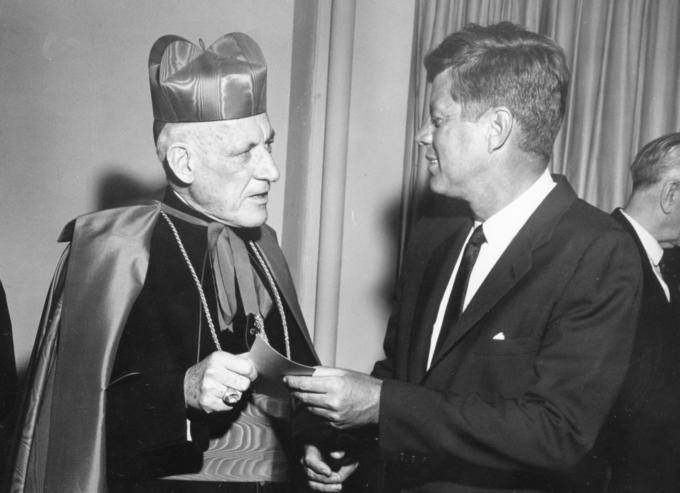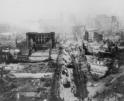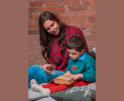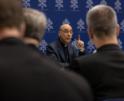
Culture
In his capacity as Archbishop of Boston, Cardinal Cushing became known as a man of vision and action.
This past Monday, Nov. 2, marked the 50th anniversary of the death of Cardinal Richard Cushing, Archbishop of Boston from 1945 to 1970. The following is a short biography of his life, the first in a series of articles that we offer to commemorate the occasion.
Richard James Cushing was born on Aug. 23, 1895, in South Boston. He was the first son and third child of Patrick and Mary (Dahill) Cushing, who, like so many of their countrymen, emigrated to the United States during the Irish potato famine. The family lived at 808 East 3rd Street, within the boundaries of Gate of Heaven Parish, when their first son was born. Cushing was baptized in that parish two days after birth, on Aug. 25, 1895, by Father Thomas Brannan.
Since Gate of Heaven did not have a parochial school, as a boy, Richard Cushing attended Boston public schools. The future cardinal was a disinterested student who dropped out during his freshman year of high school after a period of frequent truancy. Not long after dropping out, Cushing enrolled at Boston College High School, a Jesuit school where he came to learn discipline and studiousness. He continued his Jesuit education at Boston College, where he was a member of the first class to study at the university's Chestnut Hill campus.
Cardinal Cushing studied at Boston College for two years before entering St. John's Seminary in Brighton, to begin the six-year formation program for the priesthood. He was ordained to the priesthood by Cardinal William O'Connell on May 26, 1921, at the Cathedral of the Holy Cross. Father Cushing's first assignment was as curate at St. Patrick Church in Roxbury; after a brief time there, he moved on to St. Benedict Church in Somerville, where he served in the same role.
In 1922, Father Cushing appeared unannounced at the residence of Cardinal O'Connell to plead for an assignment as a missionary. The cardinal denied his request but assigned him to the Society for the Propagation of the Faith, which solicited funds for and promoted the work of missions. In 1928, Father Cushing became the director of the society, serving in this capacity until 1944.
In 1939, Pope Pius XII elevated Father Cushing to the rank of Domestic Prelate, with the title Monsignor. Two months later, he was named Titular Bishop of Mela and Auxiliary Bishop of Boston, succeeding Bishop Francis J. Spellman, who was named Archbishop of New York. On June 29, 1939, Cardinal O'Connell consecrated Bishop Cushing and appointed him pastor of Sacred Heart Church in Newton.
With the death of Cardinal O'Connell in April of 1944, Bishop Cushing was appointed diocesan administrator. That September, Pope Pius XII named him the sixth bishop and third archbishop of Boston. He was 48 years old -- the youngest archbishop in the Catholic Church. More than a decade later, in December 1958, Pope John XXIII elevated Archbishop Cushing to the cardinalate. He became one of the cardinal electors in the papal conclave of 1963, which elected Pope Paul VI.
In his capacity as Archbishop of Boston, Cardinal Cushing became known as a man of vision and action. He is well-remembered for his building programs; under his leadership, to meet the needs of an expanding Catholic population and the rapid growth of the suburbs, the archdiocese created over 80 new churches, welcomed more than 60 new religious orders of men and women, established six hospitals, and opened secondary schools, colleges, and orphanages. Retaining his commitment to missionary work, Cardinal Cushing founded the Missionary Society of St. James the Apostle for priestly service in Latin America.
Over the course of his tenure, Cardinal Cushing came to reluctantly embrace his role as a public figure and attempted to use his platform both to evangelize, fundraise and educate. He implemented a series of radio and television broadcasts of Catholic Masses in the 1940s and 1950s -- the first of their kind -- which eventually led to the founding of the archdiocesan television center in 1964. His friendship with the Kennedy family made him a national figure, both during the presidential campaign of 1960, when Kennedy's Catholicism was the subject of national attention and in 1963 when it fell to him to preside at the assassinated president's funeral.
Cardinal Cushing was plagued with health problems for most of his life, suffering from asthma, cancer, and other ailments. Because of his failing health, Cardinal Cushing retired as archbishop in September of 1970. Less than two months later, on Nov. 2, All Souls Day, he died. In the days following his death, his body lay in repose at the Cathedral of the Holy Cross. During this public mourning period, special Masses were held by the vicars of the archdiocese. On Nov. 7, 1970, funeral services were held at the cathedral, with Archbishop Luigi Raimondi, Apostolic Delegate to the United States, as principal celebrant.
Cardinal Cushing was buried at the Portiuncula Chapel of St. Francis at St. Coletta's School in Hanover, today known as the Cardinal Cushing School and Training Center.
VIOLET HURST IS AN ARCHIVIST FOR THE ARCHDIOCESE OF BOSTON.
Recent articles in the Culture & Events section
-
Boston and the nation respond to the San Francisco Earthquake of 1906Thomas Lester
-
See you in the storyLaura Kelly Fanucci
-
'Dignitas' and the mediaRussell Shaw
-
Scripture Reflection for April 14, 2024, Third Sunday of EasterDeacon Greg Kandra
-
St. Helena's House is established in the South EndThomas Lester





